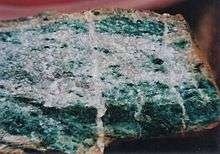Mariposite

Mariposite is a mineral which is a chromium-rich variety of mica, which imparts an attractive green color to the generally white dolomitic marble in which it is commonly found. It was named for Mariposa, California, though it can be found in several places in the Sierra Nevada mountains. It is also found in a few locations in Newfoundland, Canada, where it is called virginite, and Europe.
It is not an officially classified mineral, but is a chromium-rich phengite, which is a high silica variety of muscovite. The chemical formula is K(Al,Cr)2(Al,Si)4O10(OH)2. It is the chromium that gives it its distinctive green color.
The term "mariposite" also refers to the stone in which the green mica is found. This stone is marble, containing varying amounts of dolomite and quartz. Larger proportions of quartz give it a more attractive, translucent appearance. It is used as a decorative construction material, in walls, monuments, and bridges. It is also made into jewelry. This jewelry is sometimes sold under the trade name "Emerald Quartz".
Chemical Composition The chemical formula is K(Al,Cr)2(Al,Si)4O10(OH)2 (King, ClassicGems). Composition: Calcium 23.7% Boron 12.44% Hydrogen 3.09% Oxygen 61.39% Total: 100%
Uses
Mariposite can be used where strength and weather resistance are not required. When it comes to exterior projects using this material often the weather will turn the green eye-catching piece into a muddy brown color. This material has many different lapidaries uses. Could be used to make attractive cabochons, spheres, paperweights, bookends, and tumbled stones. Anyone that uses mariposite in various lapidary projects must be mindful that the minerals in this material are all different and create incompetent boundaries, different harnesses and polish different in the degree of luster. (King)
 A monument in Cathey's Valley, a community in Mariposa County, California, utilizing mariposite.
A monument in Cathey's Valley, a community in Mariposa County, California, utilizing mariposite. A close-up of one of the rocks in the monument.
A close-up of one of the rocks in the monument.